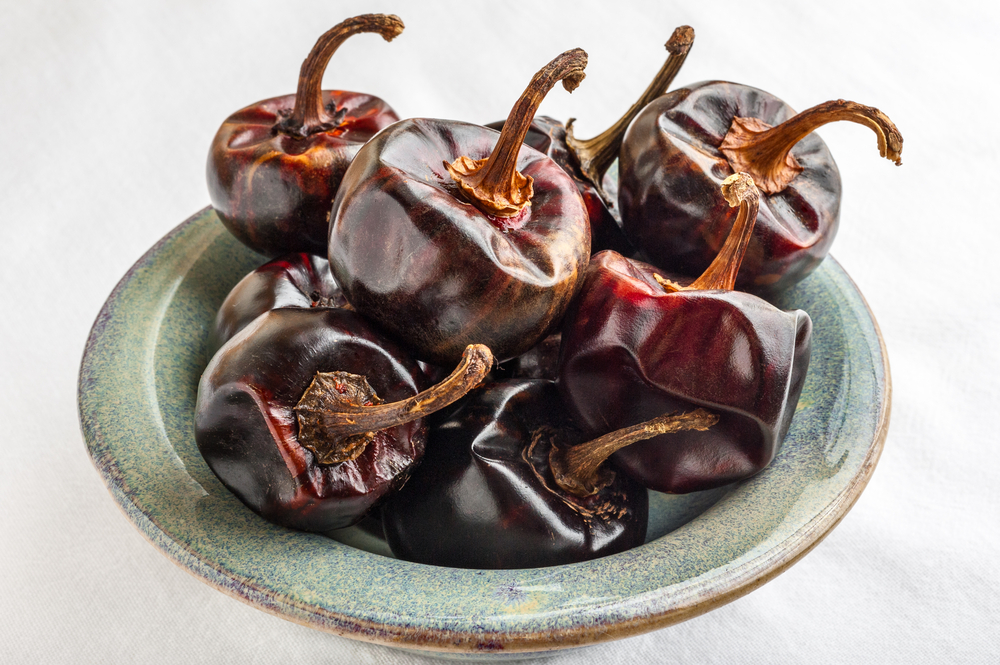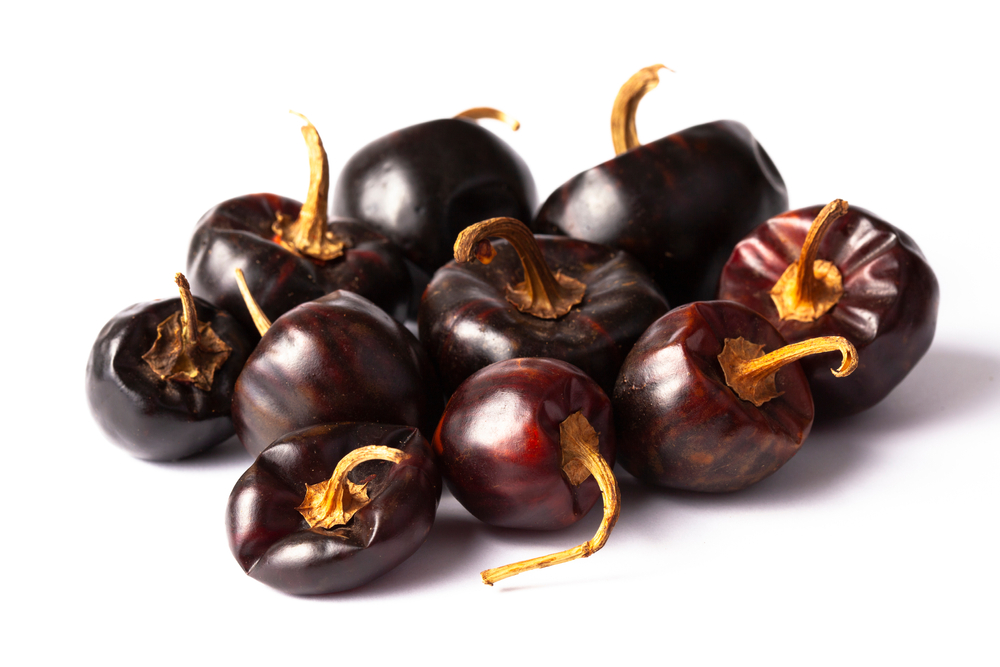Cascabel peppers are one of the few chili peppers whose seeds produce a rattling sound when shaken inside the dried pods. They are also differentiated from most other Mexican chili peppers since they have the same name for both fresh and dried versions.
What Is A Cascabel Pepper?
A cascabel pepper is a mirasol chili famous for the rattling sound made by the loose seeds when you shake the dried pepper pods. The peppers are native to Mexico, mainly grown in Jalisco, San Luis Potosi, Guerrero, Coahuila, and Durango.
Cascabel peppers are one of the many mirasol peppers that grow upward, specifically the bola mirasol. Mirasol means “facing the sun,” an unusual growth behavior observed in other pepper varieties like black cobra peppers.
You’ll find cascabel peppers also called guajones, cascabel chilis, and chile cascabel.
Because of their shape and the rattling sound of the seeds when the pods are dry, cascabel peppers have other names like chile bola (“ball chili”), rattle chile, jingle bell peppers, little bell peppers, and sleigh bell peppers. (Chile bola shouldn’t be confused with bola pepper from Europe.)
Besides the rattling sound, cascabel chiles are identified by their unique characteristics.

Color
Cascabel peppers are green, ripen to mahogany red, and finally to a deep reddish-brown when fully ripened. The deep reddish-brown color is more pronounced when the peppers are dried.
Size And Shape
Cascabel peppers look similar to a bell because of their small round shape. They are round and plump peppers with a diameter of about 1.5 inches at full maturity.
The term bola means “ball” in Spanish, which is why Cascabel peppers are called chile bola or “ball chili.”
The famous round shape of the peppers is not perfectly circular, though. The pods technically have an oval shape as they taper slightly to a blunt tip.
Another unique aspect of cascabel peppers is that, unlike other Capsicum annuum pepper varieties that flatten when dried, the pods of dried cascabel peppers retain their round shape. This hollow interior is what allows the seeds to rattle around.
The dried pods may have noticeable indentations, dimples, folds, or creases. But they blatantly refuse to flatten or wrinkle!
Texture
Fresh cascabel pepper pods at average maturity are soft and give away a little when you touch them. The overripe ones are firm to the touch and do not give.
The skin of cascabel peppers is tough, glossy, leathery, and smooth. This tough leathery skin requires breaking down by mincing, pureeing, or chopping the dried peppers once reconstituted in warm water.
Naming
It’s rare to have Mexican dried chiles sharing the same name as their corresponding fresh counterparts. Cascabel peppers depart from this tradition since their name refers to both the fresh and dried versions of the peppers.
However, you may find the dried versions of the peppers labeled as guajones and the fresh ones as chile bola or “ball chile.”
The unique naming also differs from puya peppers and guajillo chiles, which are dried mirasol pepper types and a cousin to cascabel peppers.
Rattling Seeds
As mentioned, the rattling sound in dried cascabel peppers is caused by the loose golden yellow seeds dried inside the dry, round pods.
The rattling sound, however, is not exclusively a feature of cascabel peppers. Catarina peppers also have a rattling sound caused by dried seeds and are often confused with cascabels.
The name cascabel is Spanish and translates into “sleigh bell,” “jingle bell,” “little bell,” or “rattle.”
How Hot Are Cascabel Peppers?
Cascabel peppers are mild chiles at only 1,500-2,500 SHUs (Scoville Heat Units). They have a fruity flavor with smoke, tobacco, floral, earthy, woodsy, acidic, and nutty undertones.
Cascabel chile peppers fall in the same mild heat level category as dried Espelette peppers with 500-4,000, pasilla peppers (dried chilaca peppers) with 1,000-2,500, and ancho chiles (dried poblano peppers) with 1,000-2,000 SHUs.
Dried chile de arbols and chile morita (dried, smoked overripe jalapenos) are much hotter at 15,000-30,000 and up to 10,000 SHUs, respectively. Cayenne peppers and habanero are super hot compared to cascabel peppers.
What Are The Most Common Ways Cascabel Peppers Are Used?
Cascabel peppers are often used in ground form rather than fresh or raw. They are ground into cascabel chili powder or coarse cascabel chili flakes for the following typical uses:
- Flavoring stews, casseroles, and soups.
- Making cascabel red sauce when reconstituted. The dried peppers are toasted to enhance the flavor and then rehydrated before pureeing, mincing, or chopping.
- Enhancing or making other sauces, such as cascabel-tomatillo sauce.
- Making salsa and marinades.
- Once rehydrated, the peppers are used to marinate roasted meats, incorporated into sauces for chilaquiles, chopped into salsas, or spooned over quesadillas, tacos, and fajitas.
- The rehydrated peppers are also mixed into sauces for tamales, casseroles, and enchiladas.
If you are up for it, you can use cascabel chile peppers to flavor birria, a famous “messy” traditional Mexican beef stew usually served during holidays. The term birria means “a mess” because the dish looks like a mess.

Dried Cascabel Peppers As Kitchen Art
Dried cascabel peppers have an unusual use as kitchen art. You can put them in a bowl to enjoy the sight of the deep reddish-brown round-bodied peppers.
The dried peppers are also beautiful in chili ristras and wreaths, adding a dash of red color, shape, and texture to the traditional elongated chilis used in these decorations.
Where To Buy Cascabel Peppers
Cascabel chiles are available in the Latin/Mexican aisles of grocery stores and online from retailers like Amazon, eBay, Etsy, and Walmart.
You can also find cascabel chili peppers from specialty retailers in Mexico and chile pepper farmers in the US.
If you buy peppers from online retailers like Etsy, you must check the difference between cascabels meant for art and edible ones.
Art cascabel peppers have a sealant or coating to make them glossy and long-lasting. Obviously, don’t eat these!
Substitutes For Cascabel Peppers
Even as they gain ground in Latin/Mexican grocery store aisles, cascabel chilis may still be hard to find in the United States.
Recipes calling for the peppers usually require dried cascabel peppers, which you can replace with guajillo chiles, chipotle morita peppers, ancho chiles, and arbol peppers.
Can You Grow And Dry Your Own Cascabel Peppers?
You can grow and dry your own cascabel peppers. The chili peppers are growable in pots and directly in the garden from seedlings started indoors 8-10 weeks before the last frost.
Like other peppers, the seeds are available online from retailers like Amazon and various seed exchange programs between chili pepper enthusiasts.
The peppers require warm soil to germinate into young pepper seedlings, later transferred outdoors in full sun. The soil should be moist in the growing stage to promote optimal plant development.
Outside, well-drained fertilized soil is needed to support plant growth and develop plump peppers. The peppers are ready for harvesting when they’re red or deep reddish-brown.

